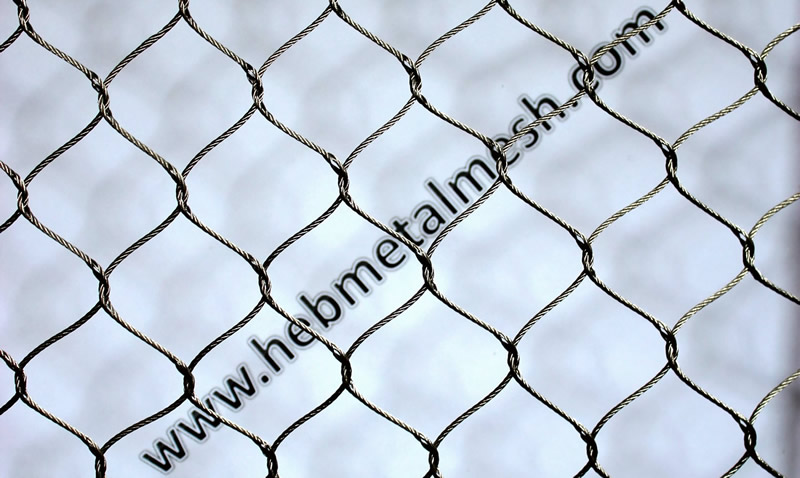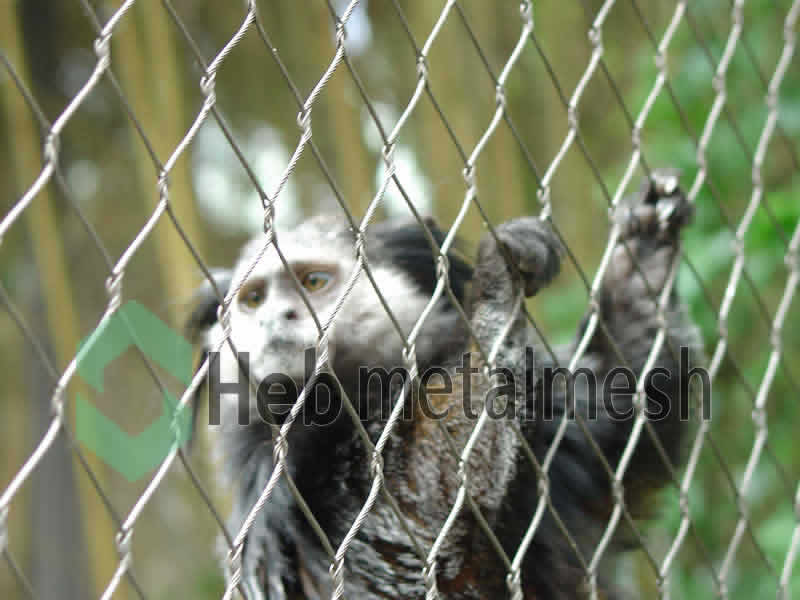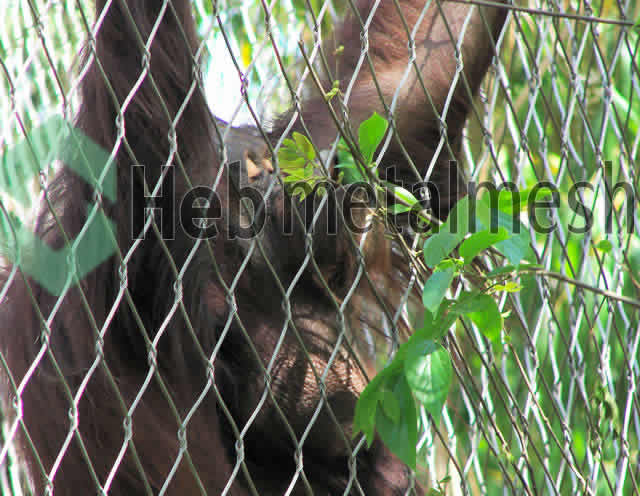Introduction to Stainless Steel Nets for Animals
✅Choose a best specification and size for net for animals of you need.
✅Contact for your customized panel size and need.
Stainless steel nets for animals have emerged as a highly regarded choice for constructing secure enclosures in both domestic and commercial settings. These nets provide numerous advantages over traditional materials such as wood or plastic, making them an essential element in a variety of applications, from wildlife sanctuaries to residential pet cages. The robustness of stainless steel mesh is largely attributed to its intrinsic properties, including corrosion resistance and structural integrity, which play a pivotal role in safeguarding the animals contained within.
One of the primary advantages of stainless steel nets is their durability. Unlike other materials that can deteriorate over time due to weather conditions or animal activity, stainless steel is engineered to withstand environmental stressors. This ensures that enclosures maintain their form and function, ultimately contributing to the safety of the animals. Furthermore, the strength of stainless steel nets effectively prevents animals from escaping, while also deterring potential predators from breaching the enclosure, which is crucial for protective measures.
Another significant benefit of using stainless steel mesh is its maintenance requirements. Compared to other materials, stainless steel nets are relatively easy to clean and maintain, providing a hygienic environment for the animals. This aspect not only helps in preserving the health of the animals but also reduces the time and effort needed for upkeep, thus making it a cost-effective option in the long run.
Additionally, stainless steel nets for animals offer a level of visibility that is generally superior to opaque materials. This transparency allows for better monitoring of the animals, promoting welfare by allowing caretakers to easily observe their behavior and health. The combination of strength, durability, and visibility makes stainless steel an ideal choice for anyone tasked with developing secure and effective animal enclosures.
Benefits of Using Stainless Steel Rope Mesh
Utilizing stainless steel rope mesh as a net for animals offers several advantages, particularly in terms of durability and long-term performance. Stainless steel is known for its remarkable strength, which ensures that the mesh can withstand considerable stress without tearing or breaking. This intrinsic strength is essential for animal containment, as it provides peace of mind to owners regarding the safety and security of their animals. Unlike other materials, which may weaken over time, stainless steel maintains its integrity, contributing to the overall effectiveness of the enclosure.
Another significant benefit of stainless steel rope mesh is its resilience against various weather conditions. This type of net for animals can endure extreme temperatures, heavy rainfall, and harsh sunlight without deteriorating. Other materials may succumb to the elements, leading to costly replacements and maintenance. In contrast, stainless steel is an ideal choice for outdoor enclosures, ensuring that animals are protected in various climates, from humid tropics to snowy regions.
Corrosion resistance is a key property of stainless steel, making it highly suitable for environments where moisture is prevalent. This feature not only prolongs the life of the net for animals but also ensures that the mesh remains visually appealing over time. The sleek, polished appearance of stainless steel enhances the aesthetic quality of animal enclosures, providing an attractive solution that integrates well with various landscapes and settings.
In summary, the unique benefits of stainless steel rope mesh, including its durability, weather resilience, corrosion resistance, and aesthetic appeal, make it a superior choice for animal containment. By investing in a stainless steel net, owners can ensure a secure, long-lasting environment for their animals, ultimately leading to a better overall experience for both the animals and their caretakers.
Different Types of Animal Enclosures
Animal enclosures come in a variety of forms, each tailored to the specific needs of the animals they house. Stainless steel nets are often employed in these designs due to their durability and effectiveness, offering excellent protection while ensuring the well-being of the animals.
One primary category of enclosures is those intended for wildlife, such as zoos and sanctuaries. These settings typically require robust structures constructed from materials that can withstand harsh environmental conditions. The use of a stainless steel net for animals in these enclosures is ideal, as it provides a sturdy barrier that ensures both safety and visibility for visitors. Wildlife enclosures often incorporate elements like climbing structures and water features, necessitating the strength and corrosion resistance that stainless steel nets offer.
Another category includes enclosures for domestic animals, such as dogs, chickens, and rabbits. These enclosures aim to create a safe environment where animals can roam freely without the risk of escape or predation. Stainless steel nets can be used in combination with other fencing materials to create a secure and safe space for pets. Design elements often include shaded areas, feeding stations, and even raised platforms for animals to explore, making the enclosure engaging and comfortable.
Exotic pets, including reptiles and birds, also require specialized housing. Enclosures for exotic animals often feature specific environmental controls, such as heating and humidity regulation. While glass or acrylic walls are common in these designs, the incorporation of stainless steel nets for animals can enhance air circulation and visibility, fostering a healthier living environment. The versatility of stainless steel nets allows for custom designs that can accommodate the unique needs of different exotic species.
Specifications for Different Animals
When selecting a stainless steel net for animal enclosures, understanding the specific requirements based on the type of animal is crucial. The specifications can vary significantly, including considerations for mesh size, wire diameter, and overall strength, which are essential to ensure the safety and well-being of the animals housed within.
For smaller animals, such as rabbits or birds, a finer mesh size is typically recommended. A mesh size of 1 inch by 1 inch is often adequate for securing small creatures, preventing escape or potential predation. The wire diameter should also be substantial enough to resist bending or breaking but fine enough to avoid injury to the animals. A diameter of around 16 to 18 gauge is generally recommended for these smaller enclosures.
In contrast, larger animals such as deer or goats require a stronger, more robust net. For these species, a mesh size of 2 inches by 4 inches provides a balance between visibility and security. The wire diameter must be thicker, usually in the range of 12 to 14 gauge, to withstand the physical strength and behavior of larger animals. Additionally, the net must have a high tensile strength to endure the potential stresses from the animals pushing against it.
Carnivorous animals, such as foxes or raccoons, necessitate even more stringent specifications. A mesh size of 3 inches by 3 inches is advisable to prevent their escape, paired with a wire diameter of 10 gauge or thicker for enhanced durability. It is also essential to consider the height and installation of the netting to prevent climbing or digging behaviors, which are common among various species.
Thus, selecting the right stainless steel net for animals involves careful consideration of these specifications to match the behavioral and environmental needs of different species, ensuring a secure and appropriate living space.
Building a Safe and Secure Animal Enclosure
Constructing a safe and secure animal enclosure is essential to ensuring the well-being of the animals housed within. The use of stainless steel nets is a popular and effective method due to their durability, corrosion resistance, and visibility. The following step-by-step guide outlines the process of building a sturdy animal enclosure using stainless steel nets.
First, begin with careful planning. Assess the space available and the specific needs of the animals you intend to house. Take into account their size, behavior, and any special requirements they may have. This preliminary analysis will help determine the dimensions and design of the enclosure, ensuring ample room for movement while minimizing escape risks.
Next, select the appropriate materials, focusing on high-quality stainless steel nets that can withstand environmental pressures and potential predators. Ensure the netting is of a suitable gauge to prevent any escape or injury, while simultaneously allowing for proper ventilation. Accompanying materials such as posts, framing, and anchoring mechanisms should also be chosen for their strength and longevity, contributing to the overall security of the enclosure.
Once materials are selected, proceed with the installation. Begin by constructing a sturdy frame using robust posts and supports, ensuring they are firmly anchored into the ground. Attach the stainless steel nets securely to this frame, maintaining tension to prevent sagging or loose areas that could be exploited. Be diligent in ensuring there are no gaps at joints or edges where animals could squeeze through.
As you complete the installation, evaluate the enclosure for safety and visibility. Test all entry points and assess potential escape routes. Remember, a well-designed enclosure not only keeps animals safe but also provides a clear view for observation, enhancing their overall environment. By following these guidelines, you will achieve a secure and well-ventilated animal enclosure, conducive to a healthy habitat.
Maintaining Your Stainless Steel Net Enclosure
Ensuring the longevity and effectiveness of stainless steel net enclosures for animals requires regular maintenance and inspection. These nets are designed to provide strong and reliable barriers, but over time, they may experience wear and tear that needs to be promptly addressed. Maintaining your enclosure can help prevent potential injuries to animals and keep their living environment safe and secure.
One of the primary maintenance tasks involves regular cleaning of the stainless steel nets. To achieve this, a simple solution of warm water and mild detergent can be effective. A soft cloth or sponge should be used to gently scrub the surfaces of the net, removing dirt, debris, and any organic material that may accumulate. Avoid using abrasive cleaners or scrubbers, as these can scratch the surface, compromising the net’s protective finish. Rinsing thoroughly with clean water is also crucial to eliminate any soap residue, which could lead to corrosion if left on the metal.
In addition to routine cleaning, frequent inspections of the net for any signs of damage are essential. Inspect the structure for signs of rust, which can indicate corrosion or degradation of the stainless steel. Pay close attention to the knots and joints where the netting is secured, as these areas may be more prone to stress and damage. If any wear is detected, it is important to take corrective actions immediately. This could involve tightening loose connections or, in more severe cases, replacing sections of the net entirely to maintain its integrity and safety functionality.
Lastly, it is advisable to monitor the surrounding environment of the enclosure. Ensure that sharp objects or abrasive surfaces are not in contact with the net, as they can cause unintentional damage. By adopting these maintenance practices, owners can extend the lifespan of their stainless steel nets for animals while guaranteeing their effectiveness in creating a secure and safe habitat.
Common Issues and Solutions in Animal Netting
When utilizing nets for animals, several challenges can arise that may affect both the functionality and safety of the enclosures. One common issue is rusting, which is particularly problematic with certain types of nets. This deterioration not only compromises the strength of the net but can also pose hazards for the animals enclosed. To mitigate this, stainless steel nets, known for their corrosion resistance, are often recommended. Employing a high-quality stainless steel net for animals ensures durability and longevity, reducing the likelihood of rust and its related complications.
Tangling is another frequent issue reported by those using nets for animal enclosures. Animals may inadvertently become caught, leading to distress or injury. To address this concern, it is advisable to regularly inspect and maintain the integrity of the netting. Securing nets in a manner that minimizes surface exposure to animals can also help reduce the risk of entanglement. Additionally, providing designated areas away from the netting where animals can engage playfully might deter them from coming into contact with the enclosure itself.
Lastly, escapes are a critical issue for animal enclosures, as gaps or weaknesses in the net can lead to unintentional animal freedom. To prevent escapes, it is essential to ensure that the net is properly tensioned and securely fastened at all points. Reinforcing the base of the net with appropriate materials can also help secure the enclosure. Regular inspections are imperative, as they allow for the identification of any potential wear or damage that could compromise the net. Adopting these preventative measures and maintaining oversight can significantly improve the safety and efficacy of stainless steel nets for animals, fostering a secure environment for both the animals and their caretakers.
Case Studies of Successful Animal Enclosure Projects
Numerous animal enclosure projects have successfully utilized stainless steel nets for pragmatic and effective solutions. These case studies highlight diverse applications, the associated challenges encountered during implementation, and the lessons learned, offering valuable insights for future enclosure builders.
One notable case is the installation of stainless steel nets in a wildlife rehabilitation center. The center faced the challenge of ensuring the safety of various species while also allowing for adequate ventilation and natural light. The stainless steel net provided a robust and flexible solution, facilitating the movement of air and light while effectively containing the animals. The durability of the net for animals ensured long-term functionality under challenging weather conditions, showcasing its resilience and reliability. This project underscored the importance of selecting the correct gauge for the net based on the species housed within the enclosure.
Another example involved a zoo expanding its animal areas to enhance visitor experience while prioritizing animal welfare. The zoo implemented stainless steel nets in the construction of a spacious aviary. The challenge here was to design an enclosure that was both secure and aesthetically pleasing, as visitors should be able to observe the birds in a naturalistic setting. Utilizing stainless steel nets allowed for unobtrusive barriers without compromising the view. Additionally, the ease of maintenance associated with stainless steel was highlighted as a significant advantage, contributing to the overall operational efficiency of the facility.
A final case study features a private sanctuary dedicated to endangered reptiles. Here, stainless steel nets played a crucial role in securing outdoor enclosures that needed to resist predators while also providing ample visibility. This project revealed the necessity of regular maintenance schedules to prevent wear and tear on the nets, emphasizing proactive management for prolonged enclosure lifespan.
These examples validate the versatility and effectiveness of using stainless steel nets for various animal enclosures, offering pragmatic solutions to common challenges while promoting animal welfare.
Conclusion: The Future of Stainless Steel Nets in Animal Management
The use of stainless steel nets for animals has seen significant advancements, driven by the evolving needs of wildlife management and animal conservation. As the industry progresses, the materials and technology used in manufacturing these nets continue to improve, allowing for enhanced durability and safety. Stainless steel, celebrated for its resistance to corrosion and environmental factors, ensures that these nets can withstand harsh conditions while protecting the animals within. This resilience promotes long-term use, reducing the need for frequent replacements and fostering sustainable practices in animal management.
Moreover, the importance of sustainability in production cannot be overstated. As awareness of environmental concerns grows, the adoption of stainless steel nets made from recycled materials is becoming increasingly prevalent. Such practices not only minimize the ecological footprint but also encourage the responsible use of resources. The future will likely see a shift towards more eco-friendly materials and manufacturing processes, reinforcing the commitment to sustainability while ensuring the safety and well-being of animals.
Looking ahead, it is anticipated that stainless steel nets will play a pivotal role in enhancing animal welfare and enclosure safety. By providing secure habitats that mitigate the risk of escapes or external threats, these nets facilitate a more controlled environment for animals, allowing them to thrive. Furthermore, innovations in design, such as flexible net configurations and multi-functional barriers, may allow for better adaptability to various species and their unique needs. As the industry embraces these changes, the role of stainless steel nets in animal management remains crucial, promising a future that not only prioritizes animal safety but also aligns with broader environmental goals.


